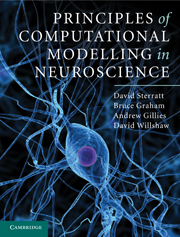Book contents
- Frontmatter
- Contents
- List of abbreviations
- Preface
- Acknowledgements
- Chapter 1 Introduction
- Chapter 2 The basis of electrical activity in the neuron
- Chapter 3 The Hodgkin–Huxley model of the action potential
- Chapter 4 Compartmental models
- Chapter 5 Models of active ion channels
- Chapter 6 Intracellular mechanisms
- Chapter 7 The synapse
- Chapter 8 Simplified models of neurons
- Chapter 9 Networks of neurons
- Chapter 10 The development of the nervous system
- Chapter 11 Farewell
- Appendix A Resources
- Appendix B Mathematical methods
- References
- Index
Chapter 8 - Simplified models of neurons
Published online by Cambridge University Press: 05 June 2012
- Frontmatter
- Contents
- List of abbreviations
- Preface
- Acknowledgements
- Chapter 1 Introduction
- Chapter 2 The basis of electrical activity in the neuron
- Chapter 3 The Hodgkin–Huxley model of the action potential
- Chapter 4 Compartmental models
- Chapter 5 Models of active ion channels
- Chapter 6 Intracellular mechanisms
- Chapter 7 The synapse
- Chapter 8 Simplified models of neurons
- Chapter 9 Networks of neurons
- Chapter 10 The development of the nervous system
- Chapter 11 Farewell
- Appendix A Resources
- Appendix B Mathematical methods
- References
- Index
Summary
In this chapter a range of models with fewer details than in previous chapters is considered. These simplified neuron models are particularly useful for incorporating into networks since they are computationally more efficient, and sometimes they can be analysed mathematically. Reduced compartmental models can be derived from large compartmental models by lumping together compartments. Additionally, the number of gating variables can be reduced while retaining much of the dynamical flavour of a model. These approaches make it easier to analyse the function of the model using the mathematics of dynamical systems. In the yet simpler integrate-and-fire model, there are no gating variables, action potentials being produced when the membrane potential crosses a threshold. At the simplest end of the spectrum, rate-based models communicate via firing rates rather than individual spikes.
Up until this point, the focus has been on adding details to our neuron models. In this chapter we take the apparently paradoxical step of throwing away a lot of what is known about neurons. Given all the painstaking work that goes into building detailed models of neurons, why do this? There are at least two reasons:
(1) We wish to explain how a complicated neural model works by stripping it down to its bare essentials. This gives an explanatory model in which the core mechanisms have been exposed and so are easier to understand.
[…]
- Type
- Chapter
- Information
- Principles of Computational Modelling in Neuroscience , pp. 196 - 225Publisher: Cambridge University PressPrint publication year: 2011

